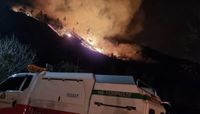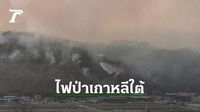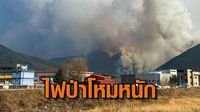South Korea is grappling with a devastating wildfire crisis that has already resulted in four fatalities and prompted the evacuation of thousands of residents. The fires, which originated on March 21, 2025, in the southeastern region of the country, have spread rapidly across multiple cities, notably Sancheong in Gyeongsangnam-do, bringing forth a state of emergency.
Reports indicate that the wildfire began in Sancheong on a Friday afternoon, igniting a rapid response from authorities. By the following day, approximately 200 residents from around 15 villages had received evacuation orders due to the dangers posed by the encroaching flames. In total, around 20,000 people were expected to have evacuated their homes as rising temperatures and strong winds fueled the inferno.
According to the South Korean forestry ministry, the escalating situation necessitated a substantial mobilization effort, involving over 300 firefighters and 20 helicopters in an attempt to contain the fires and prevent them from reaching residential areas. "We have confirmed four fatalities, including three firefighters and one official," a spokesperson from the ministry disclosed. The loss of lives underscores the dangerous conditions that fire crews are battling in their efforts to safeguard affected communities.
As the fires continue to rage, the government’s response has been swift. On Saturday, March 22, 2025, an emergency declaration was issued for the city of Ulsan, as well as for Gyeongsangnam-do and Gyeonggi-do. This declaration is a reflection of the increasing severity of the fire, characterized by its rapid movement across the landscape.
Acting President Choi Sang-mok addressed the nation stating, "The situation necessitated an urgent state of emergency due to the extensive damages." His remarks highlight the government’s acknowledgment of the crisis and the need for immediate action to protect citizens and control the wildfires.
Despite these efforts, firefighters face significant challenges. Dry weather conditions, combined with gusty winds, have made the task of controlling the blaze immensely difficult. Local media reports have indicated that certain routes leading into affected areas have been closed for safety, while firefighting teams remain on alert for potential flare-ups. Firefighting officials are working tirelessly to keep residents informed and to facilitate safe evacuations as they navigate the complex nature of this natural disaster.
The fires have not only resulted in tragic loss of life but have also caused significant property damage. It is reported that the fires have scorched nearly 20,000 acres, an expanse that can be likened to approximately 4,600 football fields. The scale of destruction has raised concerns related to community recovery and resilience in the face of such disasters.
As the crisis continues, experts urge a reevaluation of fire management strategies, particularly considering the influence of climate change, which has resulted in heightened risks for wildfires across the region. This event underlines the crucial need for better preparedness and the importance of addressing systemic vulnerabilities in environmental management.
With wildfires becoming an increasingly common occurrence during the spring months, officials remain vigilant, emphasizing that proactive measures must accompany reactive strategies. In the face of adversity, local communities are banding together to support one another. As the firefighting efforts persist, the hope remains that the damage can be contained and future incidents can be prevented.
Authorities assure the public that they continue to monitor the situation closely and are committed to providing assistance where needed. The sentiment shared among many is that the community’s resilience will shine through amid this disaster, as both citizens and officials mobilize their efforts in battling this unprecedented wildfire crisis.







